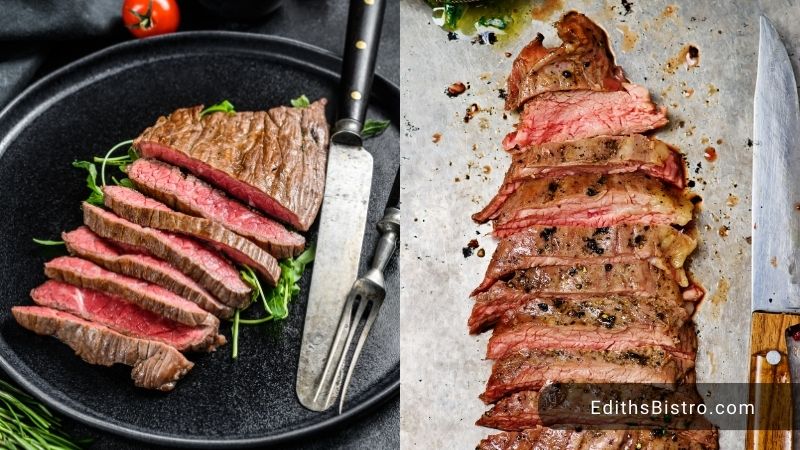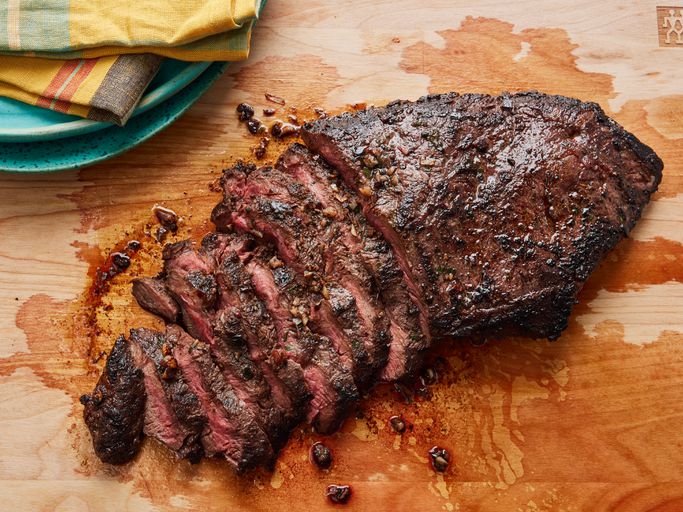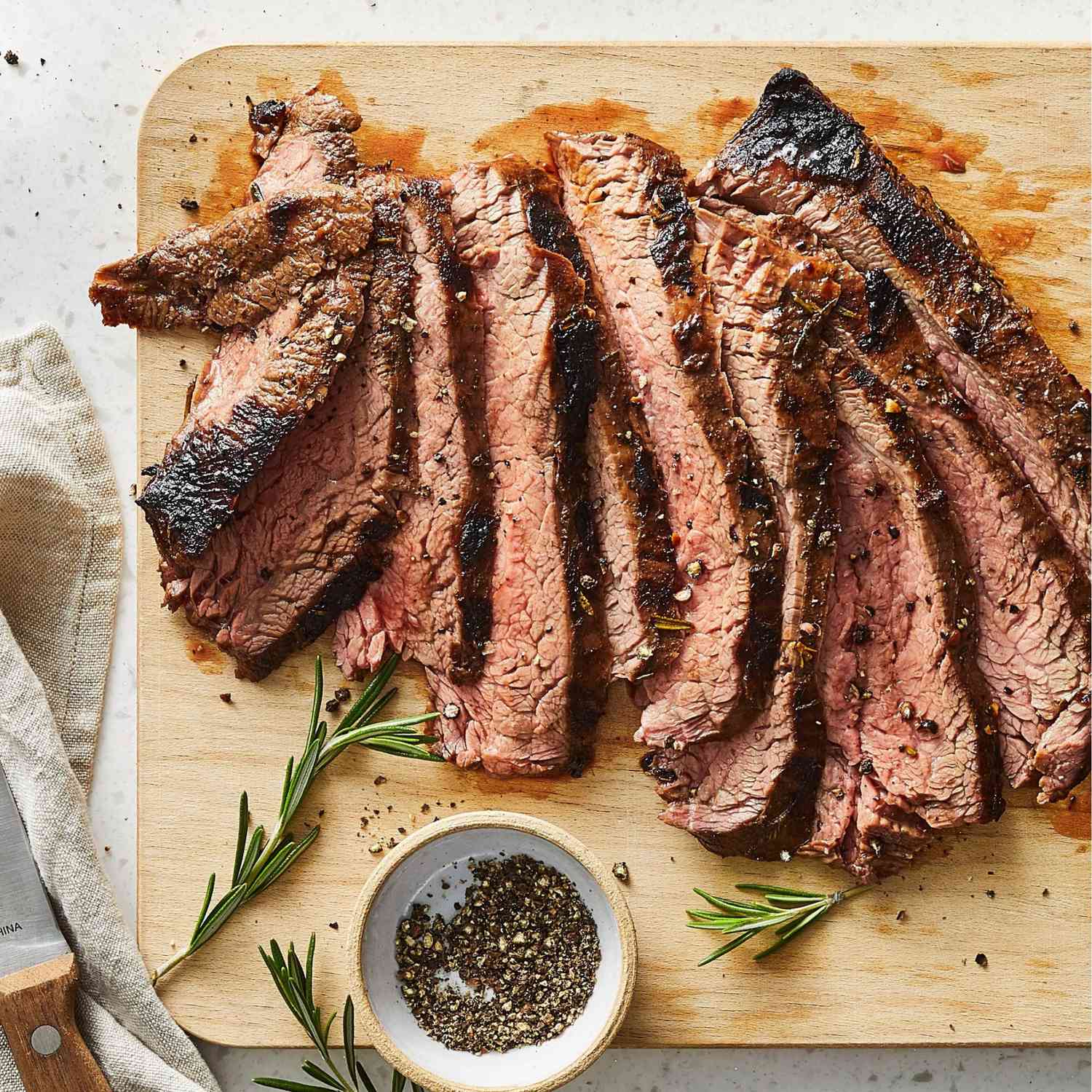Flank Steak Overview

Flank steak is a flavorful and versatile cut of beef that is loved by many. It is a lean and long muscle from the lower chest area of the cow. Flank steak is known for its robust beefy flavor and slightly chewy texture. It is often marinated to enhance tenderness and add more depth to the flavor.
When it comes to cooking methods, flank steak is best prepared by grilling or broiling. It is important to slice against the grain to ensure tenderness. Due to its flat and elongated shape, flank steak is perfect for dishes like fajitas, tacos, and stir-fries. Its ability to soak up flavors makes it a favorite choice for marinating. Overall, flank steak offers a delicious and lean option for those seeking a hearty beefy flavor in their meals.
Flank Steak Characteristics And Cooking Methods
Flank steak is known for its unique characteristics and versatile cooking methods. This lean and elongated muscle from the lower chest area of the cow possesses a robust beefy flavor and a slightly chewy texture. To enhance tenderness and add depth to the flavor, flank steak is often marinated before cooking.
The best cooking methods for flank steak include grilling and broiling. It is important to slice flank steak against the grain to ensure tenderness. The flat and elongated shape makes flank steak perfect for dishes like fajitas, tacos, and stir-fries. Its ability to soak up flavors makes it a favorite choice for marinating.
Overall, flank steak offers a delicious and lean option for those seeking a hearty beefy flavor in their meals.
Flat Iron Steak Overview
The flat iron steak is a popular and flavorful cut of beef that has gained recognition in recent years. It is derived from the shoulder area of the cow, specifically from the chuck primal cut. This steak gets its name from its shape, resembling a flat iron. The flat iron steak is known for its tenderness and rich marbling, which contributes to its juicy and succulent texture. It offers a well-balanced flavor profile, with a slightly sweet and beefy taste. Due to its tenderness, the flat iron steak can be cooked using various methods such as grilling, pan-searing, or broiling. It is a versatile cut that can be used for various dishes, including sandwiches, salads, and stir-fries. The flat iron steak provides a delicious and affordable option for beef enthusiasts.
Flat Iron Steak Flavor Profile And Cooking Techniques

The flat iron steak offers a well-balanced flavor profile that is both slightly sweet and beefy. Its rich marbling throughout the meat contributes to its juicy and succulent texture. When cooked properly, it provides a tender and melt-in-your-mouth experience.
As for cooking techniques, the flat iron steak can be prepared using various methods. Grilling is a popular choice, as it allows the steak to develop a delicious charred exterior while retaining its natural juiciness. Pan-searing is another excellent option, especially for those who prefer a crusty and flavorful exterior. Broiling is also a great way to cook flat iron steak, as it helps to lock in the moisture and develop a caramelized crust.
No matter the cooking method you choose, it is essential to keep in mind that the flat iron steak is best enjoyed cooked to medium-rare or medium doneness to preserve its tenderness and flavor.
Flank Steak Nutritional Value
Flank steak is not only delicious but also a nutritious choice for meat lovers. It offers a range of essential nutrients that can benefit your overall health. A 3-ounce serving of flank steak contains approximately 230 calories, making it a suitable option for those watching their calorie intake. It is a great source of lean protein, providing about 23 grams per serving. Flank steak is also rich in essential vitamins and minerals such as iron, zinc, and vitamin B12. Additionally, it offers a good amount of omega-3 fatty acids, which are beneficial for heart health. Incorporating flank steak into your diet can help meet your protein needs while enjoying a flavorful and nutritious meal.
Flank Steak Lean Protein And Nutrient Content
Flank steak is a fantastic source of lean protein, making it an excellent choice for individuals looking to meet their protein needs without consuming excess fat. A 3-ounce serving of flank steak provides approximately 23 grams of protein, which is essential for supporting muscle repair and growth. In addition to protein, flank steak is packed with essential nutrients. It is rich in iron, a mineral that plays a crucial role in carrying oxygen throughout the body. Flank steak also contains zinc, which supports immune function and helps with wound healing. Moreover, it is a great source of vitamin B12, which is necessary for red blood cell production and overall brain health. By incorporating flank steak into your diet, you can enjoy a delicious and nutritious meal that provides the protein and vital nutrients your body needs.
Flat Iron Steak Nutritional Value

A 3-ounce serving of flat iron steak provides approximately 162 calories and 24 grams of protein, making it a nutritious choice for those seeking a high-protein meal. In addition to being a great source of lean protein, flat iron steak is also rich in vitamins and minerals. It contains substantial amounts of iron, which is essential for oxygen transport in the body, and zinc, which supports immune function and wound healing. Additionally, flat iron steak is a good source of vitamin B12, important for red blood cell production and brain health. Incorporating flat iron steak into your diet can provide a delicious and nutrient-dense meal that satisfies your protein needs.
Flat Iron Steak Rich In Vitamins And Minerals
Flat iron steak not only offers a delicious flavor and tender texture, but it is also packed with essential vitamins and minerals. This cut of beef is a great source of iron, which is necessary for oxygen transport in the body and the production of red blood cells. It also provides a significant amount of zinc, a mineral that plays a vital role in immune function and wound healing. Additionally, flat iron steak is a good source of vitamin B12, which is important for brain health and the formation of red blood cells. By incorporating flat iron steak into your diet, you can enjoy a flavorful meal while reaping the benefits of these essential nutrients.
Flank Vs Flat Iron Steak Comparison
When comparing flank steak and flat iron steak, it’s important to consider their flavor, texture, and the best cooking practices for each cut. Flank steak offers a milder and beefier taste, but it tends to be tougher and requires marinating to achieve tenderness. On the other hand, flat iron steak is extremely flavorful with marbling, making it more tender than flank steak. It also cooks quickly and is versatile in terms of cooking techniques. Whether you choose flank or flat iron steak depends on your preferences and the dish you plan to prepare. If you’re looking for a leaner option that requires marinating, flank steak is a good choice. However, if you want a tender, flavorful cut that cooks quickly, flat iron steak is the way to go.
Flavor, Texture, And Best Cooking Practices

When it comes to flavor, flank steak offers a milder and beefier taste compared to flat iron steak. However, it can be tougher, so marinating is essential to achieve tenderness. On the other hand, flat iron steak is known for its exceptional tenderness and rich flavor due to its marbling. Its texture is more tender and juicy compared to flank steak.
In terms of cooking practices, flank steak is best cooked on high heat for a short amount of time to avoid overcooking and to retain its juiciness. It is ideal for grilling, broiling, or pan-searing. Flat iron steak, on the other hand, can be cooked using various methods such as grilling, pan-searing, or even sous vide. It cooks quickly and is best served medium-rare to medium for optimal tenderness and flavor. Whether you choose flank or flat iron steak, knowing the best cooking practices for each cut will ensure a delicious and satisfying meal.
Conclusion
In conclusion, when it comes to choosing between flank steak and flat iron steak, it ultimately depends on personal preference and the desired cooking method. Flank steak offers a milder and beefier flavor, but requires marinating to achieve tenderness. It is best suited for high heat cooking methods like grilling or broiling. On the other hand, flat iron steak is exceptionally tender and rich in flavor due to its marbling. It can be cooked through various methods, such as grilling or pan-searing. Whichever option you choose, understanding the unique characteristics and best cooking practices for each cut will ensure a delicious and satisfying steak experience. So, whether you’re in the mood for intense beefiness or unbelievable tenderness, both flank and flat iron steaks deliver their own unique qualities to satisfy your taste buds.
Choosing Between Flank And Flat Iron Steak
When it comes to choosing between flank steak and flat iron steak, it ultimately depends on personal preference and the desired cooking method. If you prefer a leaner option, with less fat and a milder flavor, then flank steak is the way to go. It is perfect for marinating and great for grilling or broiling. On the other hand, if you enjoy a more tender and juicy steak with a rich and flavorful taste, then flat iron steak is the best choice. It is known for its marbling and can be cooked using various methods, such as grilling or pan-searing. Consider the characteristics and cooking preferences mentioned earlier to make an informed decision and create a truly satisfying steak experience.
Expert Tips And Recommendations

When it comes to choosing between flank steak and flat iron steak, here are some expert tips and recommendations to consider.
- Marinating for Flavor: Both cuts benefit from marinating to enhance flavor and tenderness. Opt for acidic marinades like citrus or vinegar-based ones to help tenderize the meat.
- Slicing Technique: For flank steak, it’s important to slice against the grain to ensure optimal tenderness. This helps break up the muscle fibers and makes it easier to chew.
- Resting Time: After cooking, let the steak rest for a few minutes before slicing. This allows the juices to redistribute and ensures a juicy and flavorful bite.
- Temperature Control: Use a meat thermometer to cook the steak to the desired doneness. For medium-rare, aim for an internal temperature of 130-135°F (55-57°C).
Remember, personal preference plays a significant role in choosing the right cut. Experiment with different marinades, seasonings, and cooking techniques to find your favorite way to enjoy flank or flat iron steak.
FAQ About Flank Vs Flat Iron Steak: Beef Steak Showdown
Q: What is the main difference between Flank and Flat Iron steak?
A: The primary difference lies in the cut of the meat. Flank steak comes from the abdominal area of the cow, while Flat Iron steak is cut from the shoulder region. This results in differences in texture and tenderness.
Q: Which steak is more tender, Flank or Flat Iron?
A: Flat Iron steak is generally considered more tender than Flank steak. It is known for its tenderness and marbling, making it a popular choice among steak enthusiasts.
Q: How should Flank and Flat Iron steak be cooked?
A: Flank steak is best when cooked quickly over high heat, usually on a grill. Flat Iron steak can also be grilled but benefits from a slightly longer cooking time to break down the marbling and enhance its flavor.
Q: Are there any notable flavor differences between Flank and Flat Iron steak?
A: Yes, there are flavor differences between the two. Flank steak has a robust, beefy flavor but can be slightly tougher. Flat Iron steak is known for its rich, buttery flavor and tenderness, making it a favorite for many steak lovers.
Q: Can Flank and Flat Iron steak be used interchangeably in recipes?
A: While both steaks are delicious in their own right, they may not always be interchangeable in recipes due to their distinct textures and flavors. It’s recommended to use each cut according to the recipe to fully enjoy their individual characteristics.
Q: Which steak is better for grilling, Flank or Flat Iron?
A: Both Flank and Flat Iron steak are great for grilling, but Flat Iron steak tends to be more forgiving due to its tenderness. It’s essential to be mindful of the cooking time and temperature to achieve the desired level of doneness for either cut.

Panda Cafe offers delicious dining and takeout to Fairfax, VA.
Panda Cafe is a cornerstone in the Fairfax community and has been recognized for its outstanding Chinese cuisine, excellent service, and friendly staff.